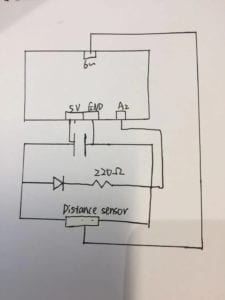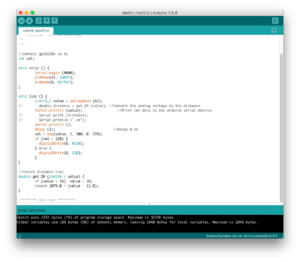The last recitation we had the opportunity to use all kind of sensor and really thought of designing the circuits ourselves. Before starting building our circuits, we first checked all the sensors and their functions. After having a basic understanding of them, we decided to use the Ultrasonic Ranger which could be able to measure the distance between its screen and the object in front of it.
Here are the components we used:
1* Arduino Uno
1 * USB A to B cable
1 * breadboard
2 * LEDs
2 * 220 ohm resistors
1 * Multimeter (optional)
1* Ultrasonic Ranger
Here are the circuit diagrams:

I and my partner hoped that the distance sensor could be able to control the LED, hence, by putting our hands at the distance in front of the sensor, the LED could be turned on or off. In order to achieve this, we first designed the circuit diagram with all the components being placed in the right position. Besides, we also needed to make sure that we connected the LED with the analog input so that we could be able to write certain code to control it. We also should connect the sensor with digital input for the same reason
In order to get the correct range of distance sensor’s data, we had to first test its capability with distance. We hoped that we could control the range of distance. For example, we wanted to tell the computer to turn the LED on when our hands got close to the sensor while turned it off when we were far away. To achieve this goal, we did a test and got the normal range of the induction distance.

After finishing assembling the circuit and editing the code, we sent the code to the Arduino, however, our circuit did not function well as we assumed it would be. This kind of situation was under our estimation because it happened all the time. We went back to check our code trying to figuring out what we have done incorrectly. Then we realized we did not
After correcting the mistake, we finally lighted the LED by waving our hand in front of it. However, later we realized even we did not wave our hands, the LED would still light up automatically, and also we could turn it off. All of these means our code were still wrong otherwise it should be able to follow our order. Hence, we had to check our code again. Then things turned out to be that we only gave the computer the order of turning on the LED, but did not input the “else” code. Because of this incomplete code, our LED could only be turned on at a certain distance, but there would not be changed after being turned on. In addition, we also failed to find the proper statistic data of “delay” and “value”.
Finally, we corrected all mistakes and the LED worked perfectly with the distance sensor. We could control the LED by moving our hands in front of the sensor. However, our experiment did not end with just one circuit. We then wondered whether we could also change the brightness of the LED by moving our hands. In order to achieve this, we must change our code. We entered another code which told the computer that the brightness should be stronger when things were closed and weaker when things were far.
Question1:
For this week’s recitation exercise, the biggest concern for me is how to really choose a sensor and design the accordingly circuit, and also, I wonder whether I can change the code base on my requirement. After the exercise, I think I have a relevantly more complete understanding of the coding process. It does not seem to be abstract as before anymore, instead, I have a more clear awareness of what am I doing right now. If our project is going to be used for the pragmatic purpose, I believe that people who are disabled may use it as an automatic switch for their house. Since the sound sensor is not very stable, and if people would like to stay in the room for a long time, then they have to make a sound all the time. By applying this distance sensor switch, as long as they are detected within a certain area, the light will always remain open.
Question 2:
For me, a beginning level learner of coding, the recipe or tutorial is playing the role of a learning map which helps me find my destination and get familiar with this land. In the beginning, there is no way for me to create my own code without knowing all the rules of this field. Hence, by following all the recipe and tutorial, I can accumulate my knowledge and practice skills until I am capable to invent my own code.
Question 3:
Manovich points out the mutual influence between computers and culture. In this process, the media develops its own culture in terms of the wide application of computer technologies. From my perspective, computers and human behaviors are already separable. They are shaping each other to create a type of new culture which is centered around hypermedia and computer technologies. By inventing all the revolutionary products, computers are involved in every corner of people’s lives. It is not we human being that has the right to reject technologies, instead, it is the way the computer technology develops that direct the civilization of human being.